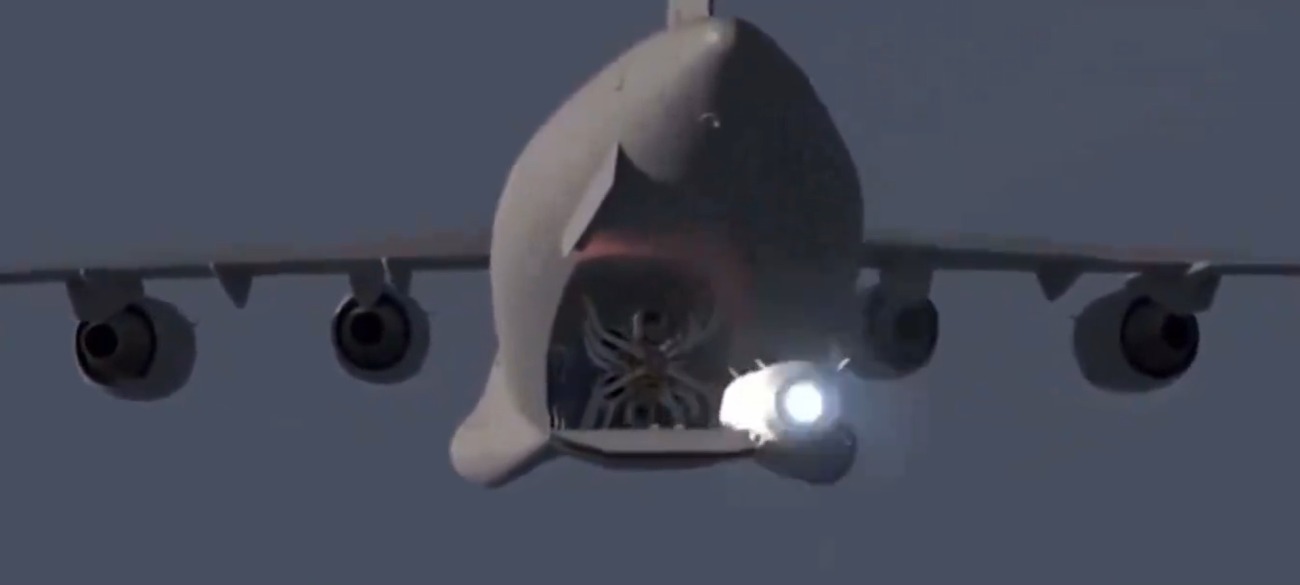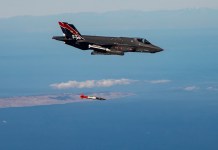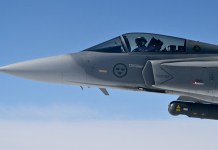The second largest strategic and tactical airlifter of the US Air Force, the C-17 Globemaster III aircraft, will pack a lethal punch in the future. Boeing has unveiled a new concept called the “Revolver” launch system, which, when integrated with the airlifter, will be able to fire several hypersonic missiles from the back of the aircraft.
‘Raptor Salad’ For Lunch! US F-22 Raptor Outgunned, Outmaneuvered By German Eurofighter Typhoon?
Considering the dispersed nature of warfare that the US Air Force (USAF) will experience in the Indo-Pacific against China, the USAF is turning its airlifters, such as the C-17 Globemaster and C-130J, into traditional bombers and giving them more offensive capabilities.
The USAF is proceeding with the intent that the prospect of war with a powerful adversary like Russia or China means that its cargo and tanker planes will need to do more than merely logistical support.
Boeing intends to integrate X-51A Waverider hypersonic cruise missiles with the Revolver system. The system will allow 12 such missiles to be fired by the advanced launcher features two sequentially installed drums and an electromagnetic catapult mechanism.
The X-51A Waverider, known for its scramjet engine, can travel at speeds exceeding Mach 5 (five times the speed of sound), enabling precision strikes over long distances. Weighing approximately 4,000 pounds (1,814 kilograms), the weapon was originally designed to be fired from a B-52 Stratofortress bomber.
The X-51 program was a cooperative effort by the Air Force, the Defense Advanced Research Agency, NASA, Boeing, and Pratt & Whitney Rocketdyne. The program was managed by the Aerospace Systems Directorate in the Air Force Research Laboratory.
X-51 technology will be used in the AFRL’s high-speed strike weapon, a Mach 5-plus missile. It was scheduled to enter service in the mid-2020s but has been delayed.
In 2013, the X-51A WaveRider unmanned hypersonic vehicle achieved the longest air-breathing, scramjet-powered hypersonic flight in history, flying for three and a half minutes on scramjet power at a top speed of Mach 5.1. The vehicle flew for a total time of more than six minutes.
Boeing unveiled the concept system through a video. The system will give ‘Buddha’ another moniker for C-17, owing to its sturdy look, which will make the aircraft more versatile. The system will allow the aircraft to carry out precise and speedy deployment of missiles in case of critical situations.
For anyone currently distrustful of Boeing may I introduce you to their new hypersonic missile revolver pic.twitter.com/4Vkm0gRmab
— Chris Combs (iterative design enjoyer) (@DrChrisCombs) June 28, 2024
The C-17 can ferry 102 paratroopers, 54 medical patients, or 85 tons of cargo. It can transport this cargo to anywhere in the world from the US with mid-air refueling. The military aircraft is an important force multiplier in the US’ global operations. The integration of the Revolver launcher will add to its role in modern military logistics.
The deployment of hypersonic missiles on aircraft like the C-17 will be highly advantageous to the operating military. This development is part of Boeing’s broader efforts to advance hypersonic technology.
The C-17 is the second largest aircraft in the US fleet after the C-5 Galaxy. It has also been in the fleets of air forces worldwide, including India, the United Kingdom, Australia, Canada, Qatar, the United Arab Emirates, and Kuwait.
Boeing was also recently selected by the Defense Advanced Research Projects Agency (DARPA) for the Glide Breaker program. This program focuses on developing a hypersonic interceptor prototype capable of destroying high-speed, maneuverable threats during the glide phase of flight.
Hypersonic Capability
While the United States is still working to develop its hypersonic weapon, China has already developed and deployed ground, air, and sea-launched hypersonic variants.
China regularly war games to destroy a US aircraft carrier group with its latest long-ranging hypersonic ballistic missile, DongFeng-27, to signal the arrival of its “Blue Dragon” strategy in the Indo-Pacific.
This major adversary of the US in the present time has been quite boastful of its hypersonic weapons program and has already been deploying them to deny area access to the US. However, the US hypersonic weapons programs are trailing owing to a lack of a plan, technological gaps, and a belief that ballistic missiles are a better and cost-effective bet against an adversary.
The Pentagon is making significant investments in hypersonic weaponry; most recently, it gave a $756 million contract for ground-based hypersonic systems to Lockheed Martin, a rival of Boeing.
In an apparent attempt to show China that the United States is still competitive in the arms race, where Beijing is thought to have an advantage thanks to missiles built to travel at least five times the speed of sound, the US Air Force tested a hypersonic cruise missile for the first time in the Pacific in March.
On March 17, a B-52 bomber from Andersen Air Force Base on Guam launched “a full prototype operational hypersonic missile,” confirmed an Air Force spokesperson in a statement to CNN.

C-17 – An Airlifter, A Bomber & Carrier Of Hypersonic Missile
Recently, the USAF’s Special Operations Task Group Central and Air Forces Central carried out a training exercise on and off-loading missile cradles from C-17s. C-17s can operate from a greater range of airfields than bombers, and the capability to deploy long-range missiles will create more challenges for the enemy.
Since early 2020, the USAF has carried out a slew of tests to drop pallets of real or simulated cruise missiles from cargo planes to see if they could deploy and strike a target. The project is known as Rapid Dragon and is overseen by the Air Mobility Command, which oversees the service’s cargo and tanker fleets.
The C-17 has so far deployed a Joint Air-to-Surface Standoff Missile-Extended Range cruise missile, which has a range of about 600 miles. The project goes beyond just giving offensive capabilities to the transport fleet; the aircraft can carry sensors and jammers for electronic warfare.
Traditionally, the C-17 Globemaster III has been deployed to carry out strategic and rapid delivery of fuel and supplies via airdrop. The big aircraft can also transport personnel. The USAF started with these transporters, as turning them into bombers required fewer modifications and training.
The C-17 is a behemoth with a payload capacity of nearly 171,000 pounds. It can transport armored vehicles, trucks, trailers, and airdrop more than 100 paratroopers and their accompanying equipment. Given its size, this plane can carry three times as many long-range precision munitions as a B-52 bomber.
The USAF is still figuring out the logistics of this transformation, as these airlifters will need to operate from more remote and austere airfields to dodge Chinese attacks. The added challenge is these palletized munitions will need to be stored and distributed for them to work effectively.
In the meantime, the program has not escaped the notice of China, which is apprehensive that these US Cargo planes can carry a large number of missiles and would be hard to track as they pick up pre-positioned palletized missiles while on other missions and then launch them from “just outside a defensive perimeter.”
The Rapid Dragon is also seen as “cost-effective,” as using cargo aircraft to drop weapons is cheaper than building more bombers, and militaries without bombers could quickly add the capability to their cargo planes.
- Ritu Sharma has been a journalist for over a decade, writing on defense, foreign affairs, and nuclear technology.
- The author can be reached at ritu.sharma (at) mail.com
- Follow EurAsian Times on Google News




